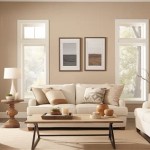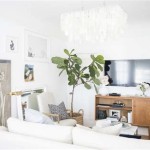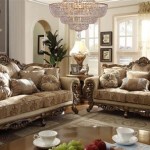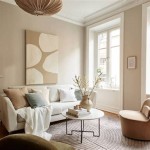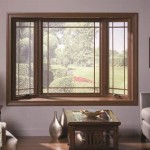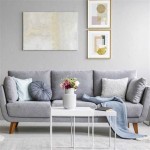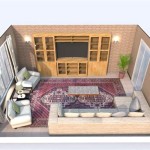Glass Decoration For Living Room: An Elegant Touch
Glass decoration in the living room provides an immediate uplift in aesthetic appeal, creating a space that is both sophisticated and welcoming. The versatility of glass allows it to be incorporated in diverse forms, from functional furniture pieces to purely decorative objects. This article explores various ways glass can be used to enhance the living room environment, focusing on its impact on light, space, and overall ambiance.
Mirrors as Architectural Enhancements
Mirrors are a classic and effective way to use glass in living room decoration. Their reflective properties contribute significantly to perceived space and natural light diffusion. A large mirror strategically placed on a wall can instantly make a small living room feel larger and brighter. The placement of the mirror is crucial. Placing it opposite a window or a light source will maximize the reflective effect, spreading light throughout the room. Alternatively, placing it near a doorway can create the illusion of a longer hallway or a connecting space.
Beyond mere size, the shape and frame of the mirror play a significant role in the overall aesthetic. A large, ornate mirror with an antique frame can add a touch of classic elegance to a traditional living room. Conversely, a frameless, minimalist mirror will blend seamlessly into a modern or contemporary space. Consider the existing style of the living room when selecting the shape and frame of the mirror to ensure a cohesive and harmonious look.
Furthermore, mirrors can be grouped together to create a gallery wall effect. Using a collection of smaller mirrors in varying shapes and sizes can add visual interest and texture to the room. This approach allows for personalization and can be adapted to suit different styles, from bohemian to eclectic. The key is to maintain a sense of balance and proportion in the arrangement, ensuring that the mirrors complement each other and the surrounding décor.
Another possibility is using mirrored furniture. Mirrored coffee tables or side tables not only reflect light but also add a touch of glamour. The reflective surface makes the furniture appear less bulky, contributing to an open and airy feel. However, mirrored furniture requires careful consideration of the surrounding elements. It works best in minimally decorated spaces where its reflective qualities can be fully appreciated without creating a cluttered or overwhelming effect.
Glass Furniture: Functionality and Style
Glass furniture is another prominent way to incorporate glass into living room design. Coffee tables, side tables, and shelving units made of glass offer a clean and modern aesthetic. The transparency of glass furniture allows light to pass through, preventing visual obstruction and contributing to a sense of openness.
Glass coffee tables are a popular choice due to their versatility. They come in various shapes and styles, from simple rectangular designs to more elaborate sculptural forms. A glass coffee table allows the area rug to remain visible, effectively tying the room together. The material of the table legs can be chosen to complement the existing decor. Chrome or stainless steel legs create a contemporary look, while wooden legs add a touch of warmth and natural texture.
Glass shelving units offer a practical and stylish storage solution. They can be used to display books, decorative objects, and plants, adding visual interest and personality to the room. The transparency of the glass allows the items on display to take center stage, creating a gallery-like effect. Glass shelving units can be particularly effective in small living rooms, as they do not block light and create the illusion of more space.
When selecting glass furniture, consider the thickness and quality of the glass. Tempered glass is a durable and safe option for furniture, as it is resistant to breakage and shatters into small, harmless pieces if broken. Also, consider the maintenance requirements of glass furniture. Glass surfaces require regular cleaning to maintain their shine and prevent fingerprints and smudges from accumulating. Glass furniture is best suited in homes that do not have small children prone to accidentally damaging the glass.
Decorative Glass Objects: Adding Character and Detail
Beyond furniture and mirrors, decorative glass objects offer a wide range of possibilities for enhancing the living room environment. Vases, sculptures, bowls, and decorative lighting fixtures made of glass can add character, texture, and visual interest to the space. The interplay of light with the glass creates a dynamic and captivating effect, transforming the living room into a visually engaging space.
Glass vases are a classic and versatile decorative accessory. They can be used to display fresh flowers, artificial arrangements, or simply as standalone objects. The shape, size, and color of the vase can be chosen to complement the existing decor. A tall, slender vase with a single stem can add a touch of elegance to a minimalist living room, while a collection of smaller vases in varying shapes and sizes can create a more eclectic and bohemian look. Consider the color of the glass vase in relationship to the colors of the flowers within.
Glass sculptures and art pieces can serve as focal points in the living room. They can be placed on shelves, coffee tables, or mantels, adding a touch of sophistication and artistry to the space. The form and texture of the glass sculpture can be chosen to reflect the personal taste and style of the homeowner. Abstract glass sculptures can add a modern and contemporary feel, while more traditional glass figurines can add a touch of classic elegance.
Decorative lighting fixtures made of glass can enhance the ambiance of the living room. Chandeliers, pendant lights, and table lamps with glass shades or accents can create a warm and inviting atmosphere. The transparency of the glass allows light to filter through, creating a soft and diffused glow. Colored glass fixtures can add a touch of vibrancy and personality to the room, while clear glass fixtures offer a more subtle and understated look. The positioning of the light source is important for creating an appealing ambiance. The angle and intensity of light will alter the way the room appears.
Finally, consider incorporating stained glass elements into the living room design. Stained glass windows or panels can add a unique and artistic touch to the space. The colorful and intricate patterns of stained glass can create a captivating visual effect, transforming the living room into a work of art. Stained glass can be incorporated into existing windows, or used to create decorative screens or partitions. The style of the stained glass should be chosen to complement the overall aesthetic of the living room.
When incorporating glass decoration into the living room, it is important to consider the overall balance and harmony of the space. Avoid overusing glass, which can create a cold and sterile atmosphere. Instead, use glass strategically to enhance the existing decor and create a visually appealing and inviting environment. Proper placement and balancing glass elements against other textures and materials will provide the greatest benefit to a living space.

5 Ways To Transform Your Room Decor With Glass

Showcase Designs For Living Room With Glass Designcafe

Fantastic Solid Glass Doors And Room Dividers Inviting Natural Light Into Modern Interior Design Door

6 Innovative Glass Interior Design Ideas For Living Room

Beautiful Glass Partition For Living Room Designcafe

5 Ways To Transform Your Room Decor With Glass

6 Innovative Glass Interior Design Ideas For Living Room

Modern Living Room Partition Wall Design 2024 Divider Ideas Home Interior Glass Window

European Style Living Room Colour Mixture Glass Mosaic Art Designs Building Material Made In Com

Living Room Interior Glass Wall Paneling

